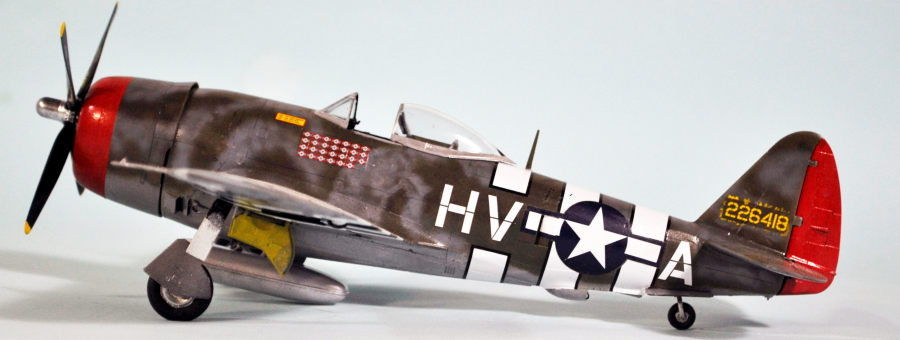
Tamiya 1/48 P-47D Thunderbolt
| KIT #: | 61090 |
| PRICE: | $53.00 |
| DECALS: | Two Options |
| REVIEWER: | Tom Cleaver |
| NOTES: | Techmod 48006 decals |

| HISTORY |
For those in need of a developmental history of the P-47, look up the June 2020 issue of Aeroplane Magazine, where I wrote a Datafile on the airplane.
Francis Gabreski:
Francis Gabreski was the top-scoring USAAF ace in the ETO with 28 victories. He was one of seven U.S. pilots to become an ace in two wars, scoring 6.5 victories over MiG-15s while flying the F-86E Sabre in the Korean War, for a total score of 34.5 to become the third highest-scoring US ace after Richard Bong and Thomas McGuire.
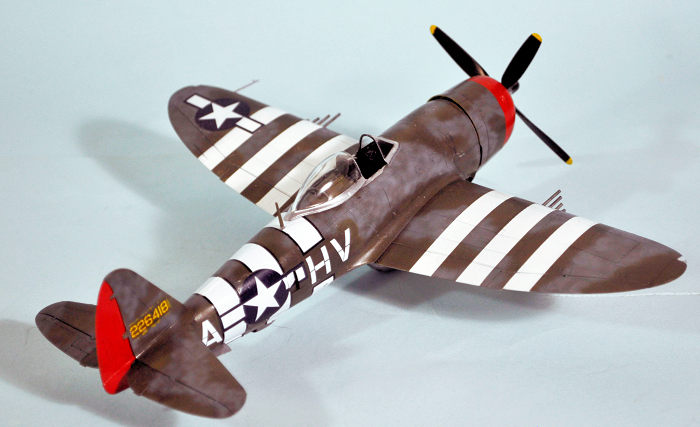 Gabreski's official Air Force biography states: “Gabreski's parents had
emigrated from Poland to Oil City, Pennsylvania, in the early 1900s. His
father (Stanisław "Stanley" Gabryszewski) owned and operated a market,
putting in 12-hour days. As in many other immigrant-owned businesses in
those days, the whole family worked at the market. But Gabreski's parents
had dreams for him, including attending the University of Notre Dame. He did
so in 1938, but, unprepared for real academic work, almost failed during his
freshman year.”
Gabreski's official Air Force biography states: “Gabreski's parents had
emigrated from Poland to Oil City, Pennsylvania, in the early 1900s. His
father (Stanisław "Stanley" Gabryszewski) owned and operated a market,
putting in 12-hour days. As in many other immigrant-owned businesses in
those days, the whole family worked at the market. But Gabreski's parents
had dreams for him, including attending the University of Notre Dame. He did
so in 1938, but, unprepared for real academic work, almost failed during his
freshman year.”
During his first year at Notre Dame, Gabreski developed an interest in flying. He took lessons in a Taylor Cub and accumulated six hours of flight time. However, he states in his autobiography that he struggled to fly smoothly and did not fly solo, having been advised by his instructor Homer Stockert that he did not "have the touch to be a pilot"
At the start of his second year at Notre Dame, Gabreski enlisted in the Army Air Corps as an aviation cadet. He survived primary flight training at Parks Air College, near East St. Louis, Illinois, where he was a mediocre trainee and was forced to pass an elimination check ride to continue training. He completed advanced training at Maxwell Field, Alabama, and was commissioned a 2nd Lieutenant in March 1941.
Assigned as a fighter pilot with the 45th Pursuit Squadron of the 15th Pursuit Group at Wheeler Army Airfield, Hawaii, Gabreski first entered the war on December 7, 1941, flying a P-36A, but the Japanese had withdrawn by the time he was able to get airborne.
In September 1942. Promoted to Captain, he convinced USAAF HQ in Washington that he should go to England as a liaison officer with the Polish squadrons since he spoke Polish, flying with the RAF to gain experience of modern combat. He was assigned to VIII Figher Command in October, and then sent to 315 Squadron (PAF) RAF, to fly on operations. He first encountered Luftwaffe opposition on February 3, when a group of Focke-Wulf Fw 190s jumped his squadron. Too excited to make a "kill", Gabreski learned that he had to keep calm during a mission, a lesson that served him well later in the war. He later spoke with great esteem about the Polish pilots and the lessons they taught him. In all, Gabreski flew 20 missions, engaging in combat once.
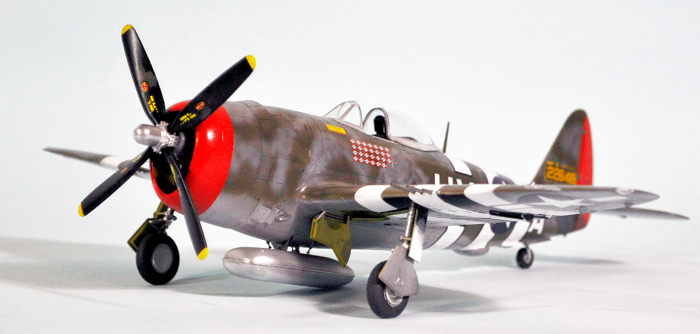 He
soon left for the 56th Fighter Group, the first USAAF unit to fly the P-47
Thunderbolt, which had recently arrived in England. He became a flight
leader in the 61st Fighter Squadron, the unit he would serve with throughout
his combat in World War II, and was promoted to Major in May. With a
combative personality and having not gone through the creation of the group
as had the others, he became an object of resentment. This only increased
when he took command of the 61st Fighter Squadron on June 9, when the
previous CO moved up to deputy group commander, since he had been jumped
over two more senior pilots, a feeling exacerbated when both were lost in
combat on June 26.
He
soon left for the 56th Fighter Group, the first USAAF unit to fly the P-47
Thunderbolt, which had recently arrived in England. He became a flight
leader in the 61st Fighter Squadron, the unit he would serve with throughout
his combat in World War II, and was promoted to Major in May. With a
combative personality and having not gone through the creation of the group
as had the others, he became an object of resentment. This only increased
when he took command of the 61st Fighter Squadron on June 9, when the
previous CO moved up to deputy group commander, since he had been jumped
over two more senior pilots, a feeling exacerbated when both were lost in
combat on June 26.
Gabreski scored his first credited kill, an Fw 190 near Dreux, France, on August 24, 1943.The event was the first of many combats in which he was criticized by his wingmen complained that his attack had not allowed them to also engage. He was never popular with wingmen and lost several in both World War II and Korea.
He became an ace when he scored his fourth and fifth victories on November 26, 1943, when the group was assigned to cover B-17s returning from a mission to Bremen.
In February 1944, Gabreski brought two Polish pilots into the 56th, who had flown with him in 1943 while serving with the RAF, including future USAAF ace Squadron Leader Boleslaw "Mike" Gladych. With Gabreski's support and to ease a shortage of experienced pilots caused by many veterans reaching the completion of their tours, the 61st FS in April accepted five other Polish Air Force pilots into the squadron as the "Polish Flight".[12]
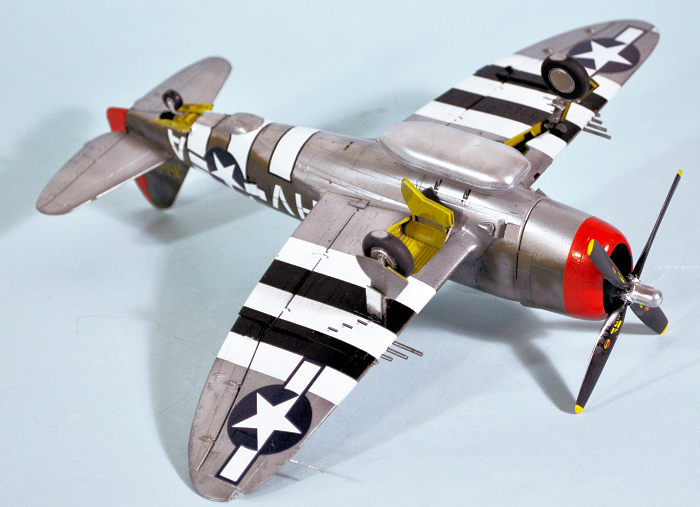 Gabreski's victory total steadily climbed through the winter of 1943–44. By
March 27, he had 18 victory credits and had six multiple-kill missions to
rank third in the "ace race" that had developed within VIII Fighter Command.
He downed only one more aircraft in the next two months, during which time
the two pilots ahead of him (Majors Robert S. Johnson and Walker M. Mahurin,
also of the 56th FG) were sent home.[13]
Gabreski's victory total steadily climbed through the winter of 1943–44. By
March 27, he had 18 victory credits and had six multiple-kill missions to
rank third in the "ace race" that had developed within VIII Fighter Command.
He downed only one more aircraft in the next two months, during which time
the two pilots ahead of him (Majors Robert S. Johnson and Walker M. Mahurin,
also of the 56th FG) were sent home.[13]
In April 1944, Gabreski was promoted to Lt. Colonel. On May 22, he shot down three Fw 190s. On June 27 he tied fellow 56th FG ace Robert S. Johnson as the leading ace in the European Theater of Operations on June 27, scoring two more on July 5, 1944, top became leading ace in the ETO, with his score of 28 destroyed matching the total of the Pacific Theatre's top ace, Richard Bong.
Scheduled to go home at the end of his tour and planning to marry his fiancé in a big wedding in his hometown of Oil City, Pennsylvania, he decided to make “one more mission.” Returning from the uneventful event, he spotted He-111s on the airfield at Niedermendig, Germany and led his flight down on a strafing attack. Dissatisfied with his first strafing run on an He 111, and he reversed for a second pass, taking out a camera to record the victory. When his tracers went over the parked bomber, he dropped the nose of his P-47 to adjust, and its propeller clipped the runway, bending the tips. The damage forced him to crash land. Running into nearby woods, he eluded capture for five days before spending the rest of the war as a POW at Stalag Luft I.
| THE KIT |
Over the past 18 years or so since it was first released, Tamiya’s series of P-47s have been recognized as “definitive” in 1/48 scale. The kit is so well-designed that a modeler has to sit down and plan how to screw things up, to avoid a perfect result if one is willing to read and follow the instructions.
| CONSTRUCTION |
My only deviation from an OOB build was to use Eduard steel photoetch seatbelts in the cockpit. I assembled this model with the flaps raised, for the purposes of painting the scheme I was doing it for. As with most kits that have dropped flaps, the parts prefer assembly in the “down” position, but putting them up presents few problems other than assuring they do in fact get into the proper position.
| COLORS & MARKINGS |
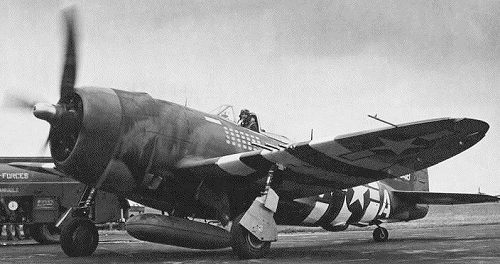 To start,
for an airplane as well-known as this is, it is very poorly documented
pictorially, which has meant over the past 50 years – since Monogram first
released their “bubbletop” with these markings and the airplane as the boxart –
that many modelers have tried and many have not been successful at cracking the
mystery of Gabreski’s Thunderbolt. From my first attempt to do this back when
that kit was new through three other tries, I didn’t get close. But over the
past 15-20 years, more research has become available. Plus I got to talk
first-hand to The Man Himself 20 years ago, who turned out to be one of the few
pilots I’ve ever interviewed who had any detailed personal knowledge of what his
airplane looked like.
To start,
for an airplane as well-known as this is, it is very poorly documented
pictorially, which has meant over the past 50 years – since Monogram first
released their “bubbletop” with these markings and the airplane as the boxart –
that many modelers have tried and many have not been successful at cracking the
mystery of Gabreski’s Thunderbolt. From my first attempt to do this back when
that kit was new through three other tries, I didn’t get close. But over the
past 15-20 years, more research has become available. Plus I got to talk
first-hand to The Man Himself 20 years ago, who turned out to be one of the few
pilots I’ve ever interviewed who had any detailed personal knowledge of what his
airplane looked like.
In May,
1944, the 56th Fighter Group began applying in-the-field camouflage to their NMF
P-47s in anticipation of the coming invasion. All were done with RAF paints (as
were all other in-the-field camo jobs in other groups; it was what was
available) and most were done in an “RAF style” two-color disruptive pattern of
either Ocean Grey and Dark Green or Sea Grey Medium and Dark Green. It has been
fairly established by researchers (I confirmed this talking to Hub Zemke in 1984
and Gabreski in 2001) that the undersides were left unpainted. That’s because
painting an airplane “in the field” sitting on its gear isn’t easy, as Merle
Olmstead once pointed out in talking about the painting of 357th FG P-51s.
Mistaking the lower surfaces as being painted a light grey is easy if you
consider that aluminum exposed to the elements
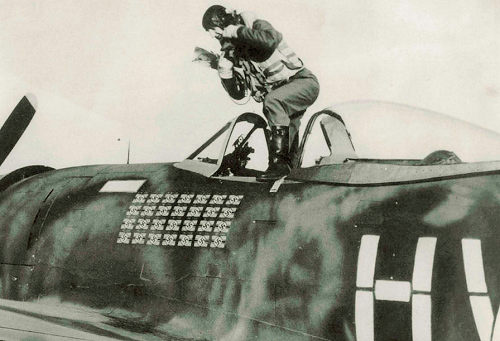 does “go grey” over time, and a
black and white photo can easily lead to an incorrect analysis. Vallejo has
brought out an interesting metallic color “Dull Aluminum,” which does indeed dry
with a “grey tinge”, which I used on this project. I think it proves the point
when viewed.
does “go grey” over time, and a
black and white photo can easily lead to an incorrect analysis. Vallejo has
brought out an interesting metallic color “Dull Aluminum,” which does indeed dry
with a “grey tinge”, which I used on this project. I think it proves the point
when viewed.
While
everyone else was doing “RAF style,” Gabreski asked his painters to do a
“Luftwaffe style” camouflaged with one of the colors “blotched.” Study of the
available photos will clearly show this, most obviously the close-up shot of him
getting out of the cockpit. Study of the two shots from the left side also show
that the grey paint that was applied over the dark green was applied around the
ID letters (I had to go back around the decals once applied to insure this).
Study of the shots the Germans took of the airplane after it crashed, when the
upper D-Day stripes had been removed, also show the area where they were to be
Dark Green originally, with some new areas of Ocean Grey blotched over; this is
useful in determining that it is indeed the case that the fuselage stripes did
not include black – at least initially – as is also shown in the two shots of
the airplane from the left with the stripes applied. Also, the one color shot of
the airplane does c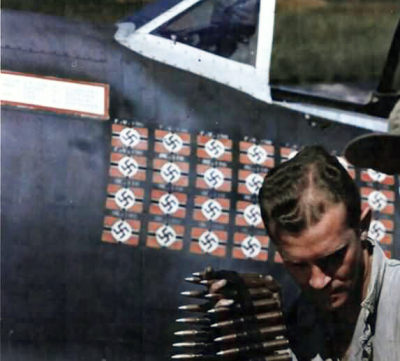 onfirm that the upper grey is dark enough to more likely be
Ocean Grey than the Sea Grey Medium some decal manufacturers have called out.
onfirm that the upper grey is dark enough to more likely be
Ocean Grey than the Sea Grey Medium some decal manufacturers have called out.
 There is
only a short roll of motion picture film that reveals the markings on the right
side of the airplane. One reveals a larger area of Ocean Grey blotching on the
fuselage than many assumed. The other, which shows the upper right wing, reveals
that there were (at that time) no black areas of the upper stripes, since the
area between the stripes is the same tone as the areas inboard and outboard of
the stripes. The lack of upper wing black stripes is also indicated by looking
at the “famous” shot of the airplane, taken from 10 o’clock low, which shows on
closer examination a line of “dark and light” along the leading edge of the wing
for the area of the black lower stripes.
There is
only a short roll of motion picture film that reveals the markings on the right
side of the airplane. One reveals a larger area of Ocean Grey blotching on the
fuselage than many assumed. The other, which shows the upper right wing, reveals
that there were (at that time) no black areas of the upper stripes, since the
area between the stripes is the same tone as the areas inboard and outboard of
the stripes. The lack of upper wing black stripes is also indicated by looking
at the “famous” shot of the airplane, taken from 10 o’clock low, which shows on
closer examination a line of “dark and light” along the leading edge of the wing
for the area of the black lower stripes.
Unfortunately, most decal makers haven’t gotten all this in their painting and marking instructions. The Techmod sheet (the first to get it right about natural metal) that I used calls out Sea Grey Medium for the upper grey, and the upper camouflage pattern they provide is not congruent with the photos (not to mention, their national insignia decals for the fuselage are too big, something “discovered the hard way” in this project – thank goodness for the kit decals).
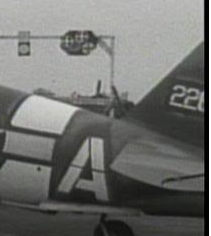 Another
small but important thing is that the serial number on the vertical fin was done
with a stencil, and a narrow “overspray” of yellow around the stencil can be
seen outlining the serial. I did this by taping over the decal with drafting
tape, then”spotting” yellow around the edge with a 0000 brush.
Another
small but important thing is that the serial number on the vertical fin was done
with a stencil, and a narrow “overspray” of yellow around the stencil can be
seen outlining the serial. I did this by taping over the decal with drafting
tape, then”spotting” yellow around the edge with a 0000 brush.
The important thing to remember is that the airplane was “a work in progress” during the eight weeks Gabreski flew it before he downed himself on July 20, 1944. Thus, the closest anyone can get to anything “definitive” is a representation of the airplane at a particular point in time so far as the markings are concerned.
One final interesting point was made to me by a good friend who pays attention to such details – that unlike almost all other 56th Group P-47s that show up in Jeff Ethell’s “World War II in color” books, Gabreski’s airplane wasn’t polished. I have since “dulled” the model in light of this information.
I assembled the landing gear and attached it and unmasked the canopy and positioned it open.
| CONCLUSIONS |
To my mind, Tamiya’s P-47s are tied with their Corsairs for being well-detailed and easy to assemble, providing any modeler from a newbie to a grizzled veteran an opportunity to create an excellent model. The P-47s can be found nowadays at eBay for very attractive prices and are highly recommended.
Review kit courtesy of my wallet.
May 2019
Copyright ModelingMadness.com
If you would like your product reviewed fairly and fairly quickly, please contact the editor or see other details in the Note to Contributors.
Back to the Main Page Back to the Review Index Page Back to the Previews Index Page